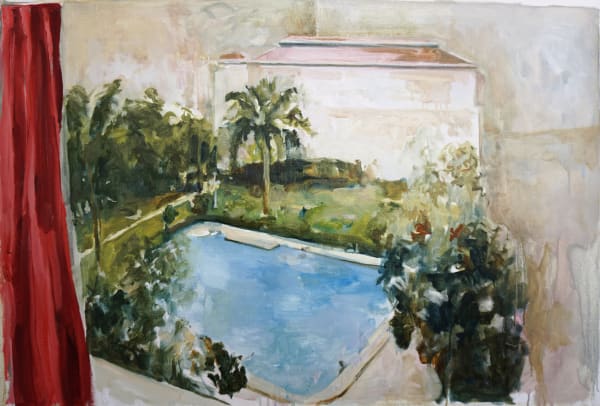Ota Fine Arts Singapore is delighted to present SPACES, a group exhibition featuring 6 artists from Singapore: Kray Chen, Sheryl Chua, Debbie Ding, Hilmi Johandi, Tristan Lim and Ian Tee. This exhibition showcases each artist's reaction to the spaces and structures in contemporary society, as well as a more formal focus on pictorial space. From painting to photography, video, 3D print and textile work, diverse expressions by the artists discuss relations between the virtual/imaginary and actual spaces.
Contemporary society is characterized by highly urbanized environments. Unable to dig for material remains for clues of the recent human past, Debbie Ding (b. 1984) takes on the role of a digital archaeologist excavating the remains of human spaces from databases of automatically uploaded cloud galleries where she has found hundreds of poorly scanned domestic interiors which were converted into 3D models with incomplete surfaces. She then fixes the gaps in the models and plane-cuts them into new forms, like a geode being cut open for voyeuristic examination. This digital fossil, or "Space Geode" as the work is titled, is an inversion of interior into exterior - the domestic interior space is converted into an object - fossilizing a moment in space and time. Hilmi Johandi (b. 1987) has a similar interest in collecting fragments of recorded physical landscapes. In particular, he looks at documented footage of Singapore from the 60s to 80s, from which he extracts elements and, as the protagonist, reconstructs them into his paintings and video works. Partially framed by a red stage curtain or the back of a wooden backdrop panel, there is a suggestion that the scene depicted could be an imaginary one, or part of a staged narrative. Through the re-contextualization of historical imagery, the works also explore themes of alienation, the social and geographical effects of rapid development, and the politics of spatial and infrastructural forms.
Kray Chen's (b. 1987) work Not Sure What to Eat for Dinner (2015) is a two-channel video installation that depicts a virtual supermarket where the artist roams in the long, maze-like aisles. Everything seems to be ordinary until we see him "cross over" from one channel to the other - he glitches and splits into two beings. This process repeats itself until the supermarket is filled with endless clones of the artist. The work is inspired by the artist's experience of getting lost in a French suburb, which he compares to the supermarket for its grid-like structure of aisles alike an organized maze. The supermarket - familiar yet generic - becomes a virtual environment through the surreal situation presented in the work, and this displacement allows the viewer to ponder on the notion of options and choices against the structural backdrop of today's society. In a related train of thought, Sheryl Chua (b. 1991) looks at the mundane sceneries of the urban city and recreates imaginary scenes from actual ones. Using photography as her main medium, she documents her surroundings, compositing her photographs into collages that form surreal images reminiscent of spaces or places. She investigates the very definitions of the words 'space' and 'place', with the former referring to a general expanse of area and the latter associated with memory, relationship and attachment. Coined by Chua, the work's title SPLACE is a combination of both words, describing an in-between illusory place that is at once familiar yet foreign, reflected through her depiction of abstract scenes of imaginary landscapes.
On the other hand, Tristan Lim (b. 1993) explores image, space and dimensionality through his video work, Lying Surface (2018). The work is made up of three main scenes: the first, of a misty scenery that becomes destabilized by artificial winds; the second of a high-quality CGI cinematic meteor with its 'realness' broken by a low-quality particle that mimics it; the third of a man walking, only for the distance to be stretched in the Z-axis, a depth that exists in virtual spaces. In the beginning of the video, these scenes warp slightly, picking up pace towards the end where, eventually, the 2D digital space distorts into what appears to be a 3D form alike a cloth collapsing into a corner. These series of visual effects distort the viewer's perception of the screen, emphasizing the artificiality that permeates our everyday lives. Also looking into pictorial space, Ian Tee's (b. 1994) works from the FIRE BLANKET series (2017, ongoing) contain visual cues to geometric abstract painting, rethinking notions of composition such as the modernist ideas of dynamic equilibrium and relational gestures. The use of fire blankets and textiles sewn together resembling a patchwork quilt alludes to the intimate relationship between fabric and the body as well as feelings of comfort, protection, care and love. The juxtaposition between the work's formal graphic qualities and its tactile associations highlights parallels between how it looks and how it feels, its material properties and function. Tee's compositions open a space for new associations and relationality beyond the edges of painting.
Featuring works of various media, this exhibition presents the unique observations and viewpoints of the six artists on their surrounding environments. Ota Fine Arts invites you to experience these works and reflect on the realities of our post-modern world.
-
 Hilmi JohandiHotel, 2016Oil on linen61 x 90 cm
Hilmi JohandiHotel, 2016Oil on linen61 x 90 cm -

KEM CHEN
Not Sure What to Eat for Dinner, 2015, 2-chennel video, 09' 15", Edition of 3 -

SHERYL CHUA
Splace 01, 2010. Hahnemuhle cotton rag on Dilite, 66 x 59.1 cm, Edition of 4 -

DEBBIE DING
Mikey's living room, mix, 2018, Remixed from Mikey's living room by Zsoa Valyi-Nagy on October 2014 12:33:42
-

TRISTAN LIM
Lying Surface, 2018, HD video loop, 03' 50", Edition of 5
-

IAN TEE
Fire Blanket 01, Fibre-glass fire branket, bleach, old clothes, waterproof canvas from disused poncho, acrylic paint on rag, sfaety straps, 181 x 184 cm








